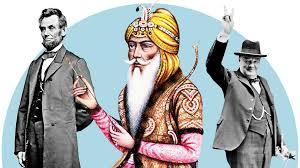Rise to fame, early conquests Of Ranjit Singh:
Ranjit Singh's fame grew in 1797, at age 17, when the Afghan Muslim ruler Shah Zaman, of the Ahmad Shah Abdali dynasty, attempted to annex Panjab region into his control through his general Shahanchi Khan and 12,000 soldiers. The battle was fought in the territory that fell in Ranjit Singh controlled misl, whose regional knowledge and warrior expertise helped resist the invading army. This victory gained him recognition. In 1798, the Afghan ruler sent in another army, which Ranjit Singh did not resist. He let them enter Lahore, then encircled them with his army, blocked off all food and supplies, burnt all crops and food sources that could have supported the Afghan army. Much of the Afghan army retreated back to Afghanistan.
In 1799, Raja Ranjit Singh's army of 25,000 Khalsa, supported by another 25,000 Khalsa led by his mother-in-law Rani Sada Kaur of Kanhaiya misl, in a joint operation attacked the region controlled by Bhangi Sikhs centered around Lahore. The rulers escaped, marking Lahore as the first major conquest of Ranjit Singh. The Sufi Muslim and Hindu population of Lahore welcomed the rule of Ranjit Singh. In 1800, the ruler of Jammu region ceded control of his region to Ranjit Singh.
In 1801, Ranjit Singh proclaimed himself as the "Maharaja of Punjab", and agreed to a formal investiture ceremony, which was carried out by Baba Sahib Singh Bedi – a descendant of Guru Nanak. On the day of his coronation, prayers were performed across mosques, temples and gurudwaras in his territories for his long life. Ranjit Singh called his rule as "Sarkar Khalsa", and his court as "Darbar Khalsa". He ordered new coins to be issued in the name of Guru Nanak named the "NanakShahi" ("of the Emperor Nanak").
Ranjit Singh's fame grew in 1797, at age 17, when the Afghan Muslim ruler Shah Zaman, of the Ahmad Shah Abdali dynasty, attempted to annex Panjab region into his control through his general Shahanchi Khan and 12,000 soldiers. The battle was fought in the territory that fell in Ranjit Singh controlled misl, whose regional knowledge and warrior expertise helped resist the invading army. This victory gained him recognition. In 1798, the Afghan ruler sent in another army, which Ranjit Singh did not resist. He let them enter Lahore, then encircled them with his army, blocked off all food and supplies, burnt all crops and food sources that could have supported the Afghan army. Much of the Afghan army retreated back to Afghanistan.
In 1799, Raja Ranjit Singh's army of 25,000 Khalsa, supported by another 25,000 Khalsa led by his mother-in-law Rani Sada Kaur of Kanhaiya misl, in a joint operation attacked the region controlled by Bhangi Sikhs centered around Lahore. The rulers escaped, marking Lahore as the first major conquest of Ranjit Singh. The Sufi Muslim and Hindu population of Lahore welcomed the rule of Ranjit Singh. In 1800, the ruler of Jammu region ceded control of his region to Ranjit Singh.
In 1801, Ranjit Singh proclaimed himself as the "Maharaja of Punjab", and agreed to a formal investiture ceremony, which was carried out by Baba Sahib Singh Bedi – a descendant of Guru Nanak. On the day of his coronation, prayers were performed across mosques, temples and gurudwaras in his territories for his long life. Ranjit Singh called his rule as "Sarkar Khalsa", and his court as "Darbar Khalsa". He ordered new coins to be issued in the name of Guru Nanak named the "NanakShahi" ("of the Emperor Nanak").
Rise to fame, early conquests Of Ranjit Singh:
Ranjit Singh's fame grew in 1797, at age 17, when the Afghan Muslim ruler Shah Zaman, of the Ahmad Shah Abdali dynasty, attempted to annex Panjab region into his control through his general Shahanchi Khan and 12,000 soldiers. The battle was fought in the territory that fell in Ranjit Singh controlled misl, whose regional knowledge and warrior expertise helped resist the invading army. This victory gained him recognition. In 1798, the Afghan ruler sent in another army, which Ranjit Singh did not resist. He let them enter Lahore, then encircled them with his army, blocked off all food and supplies, burnt all crops and food sources that could have supported the Afghan army. Much of the Afghan army retreated back to Afghanistan.
In 1799, Raja Ranjit Singh's army of 25,000 Khalsa, supported by another 25,000 Khalsa led by his mother-in-law Rani Sada Kaur of Kanhaiya misl, in a joint operation attacked the region controlled by Bhangi Sikhs centered around Lahore. The rulers escaped, marking Lahore as the first major conquest of Ranjit Singh. The Sufi Muslim and Hindu population of Lahore welcomed the rule of Ranjit Singh. In 1800, the ruler of Jammu region ceded control of his region to Ranjit Singh.
In 1801, Ranjit Singh proclaimed himself as the "Maharaja of Punjab", and agreed to a formal investiture ceremony, which was carried out by Baba Sahib Singh Bedi – a descendant of Guru Nanak. On the day of his coronation, prayers were performed across mosques, temples and gurudwaras in his territories for his long life. Ranjit Singh called his rule as "Sarkar Khalsa", and his court as "Darbar Khalsa". He ordered new coins to be issued in the name of Guru Nanak named the "NanakShahi" ("of the Emperor Nanak").
0 Comments
0 Shares


